Head of an adolescent boy (Tiberius Gemellus ?)
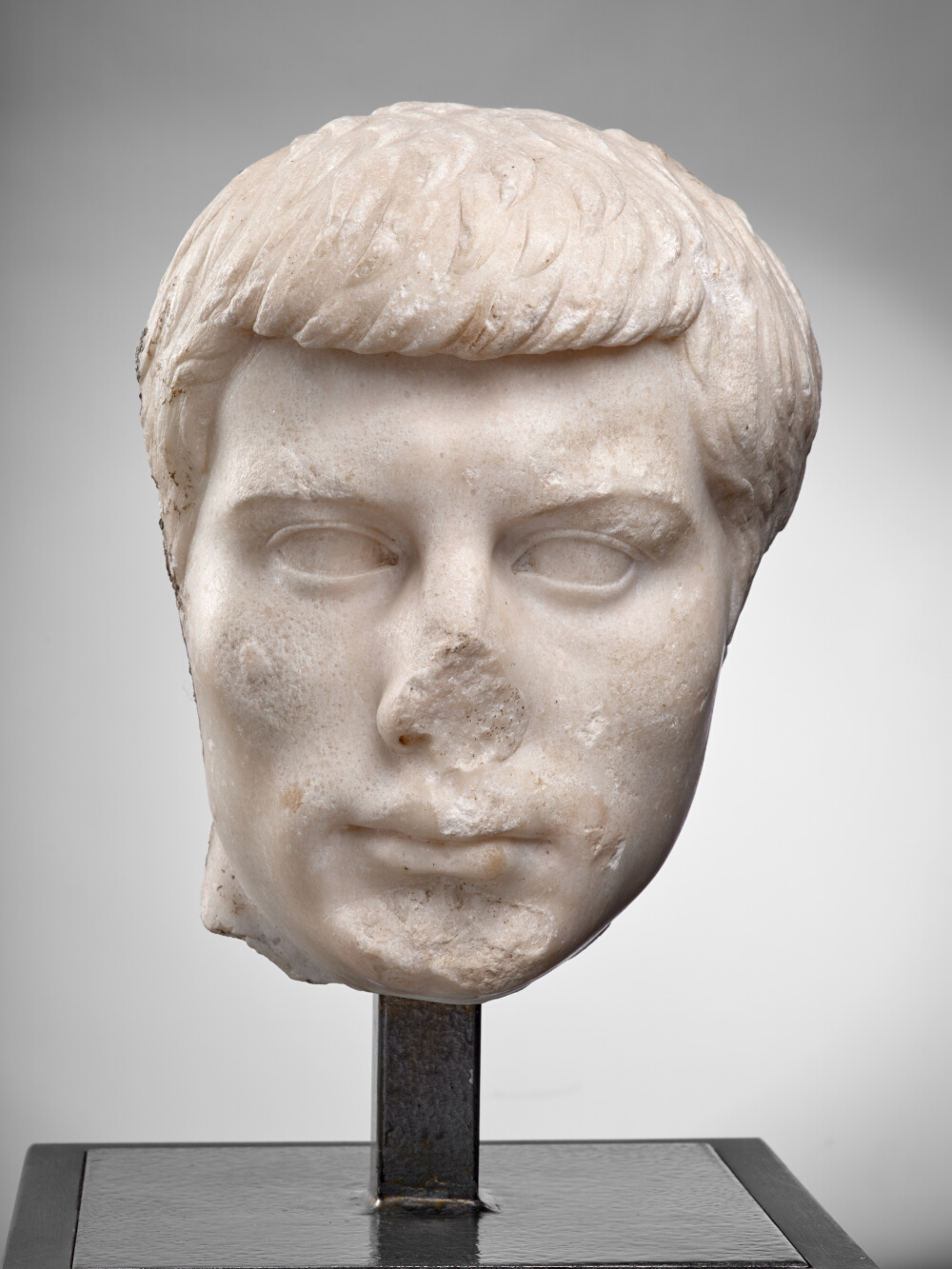
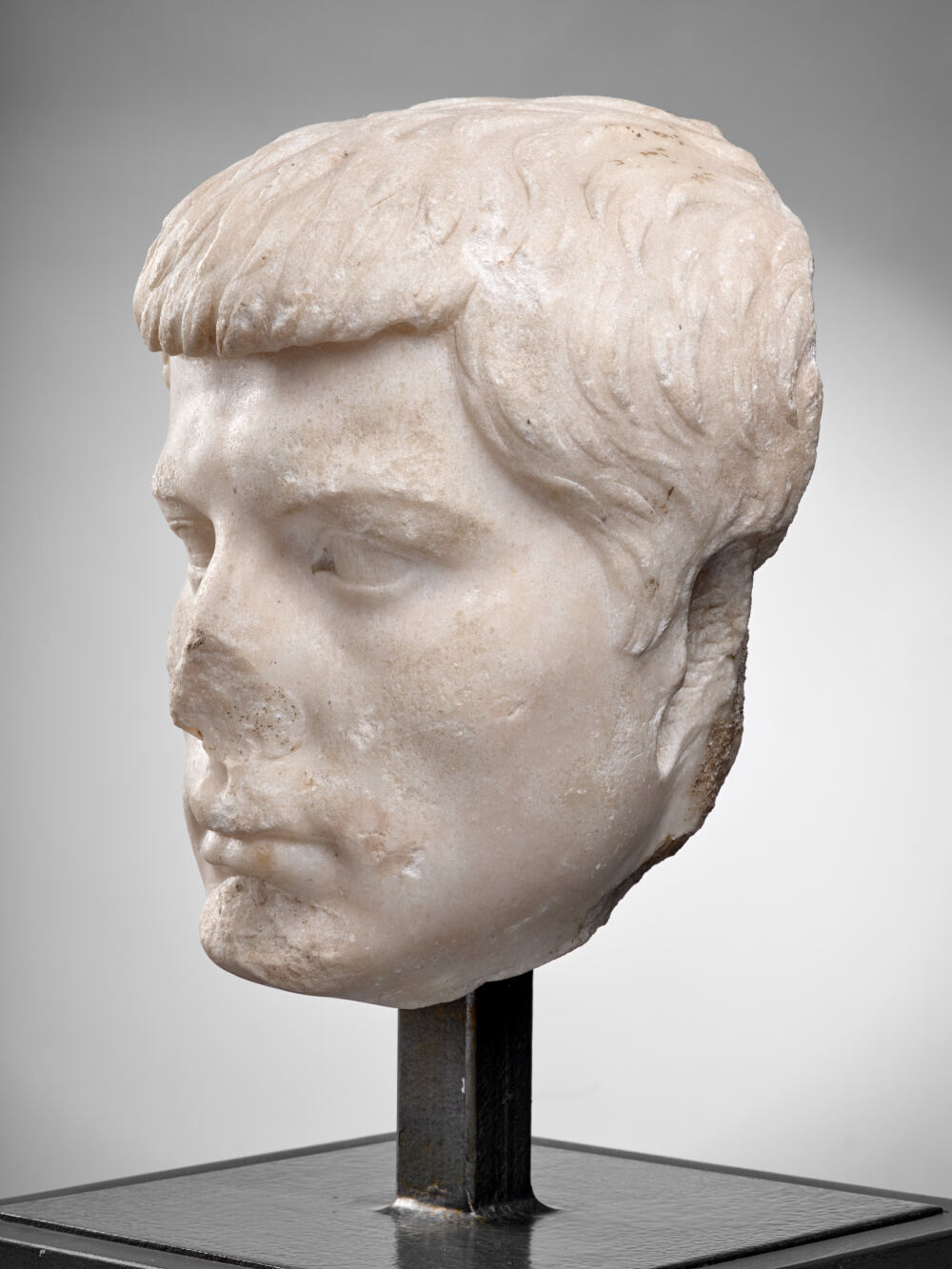
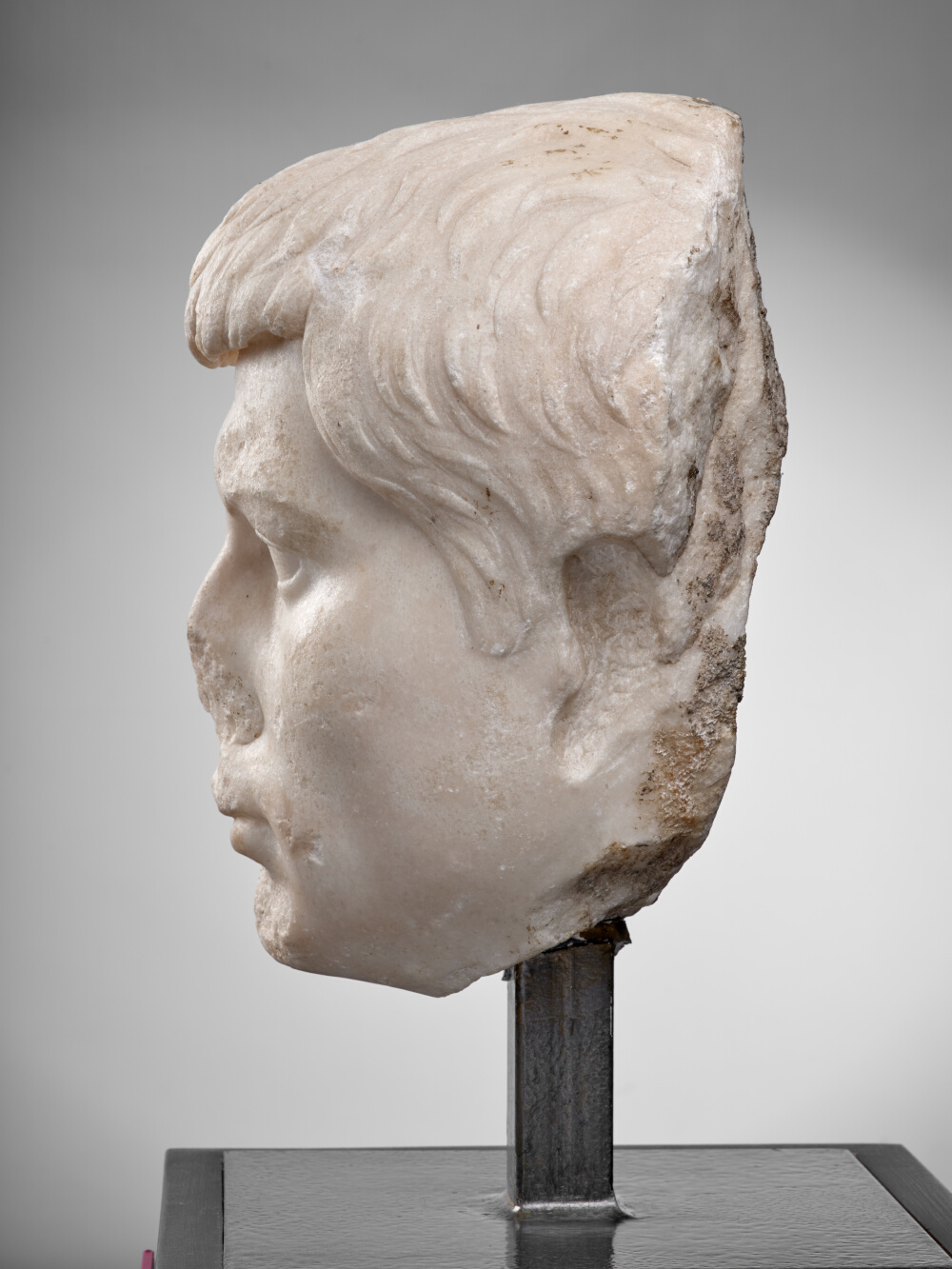
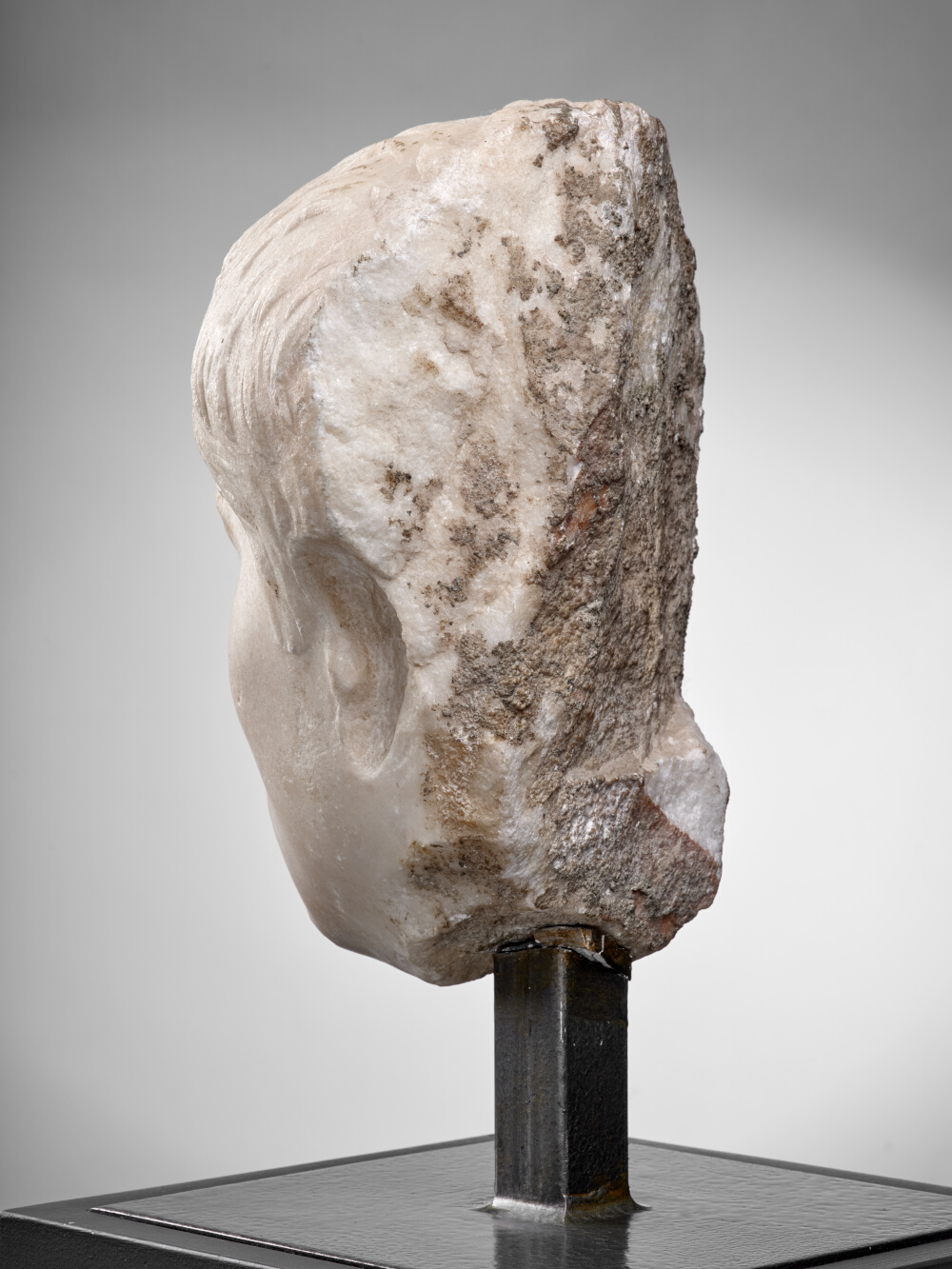
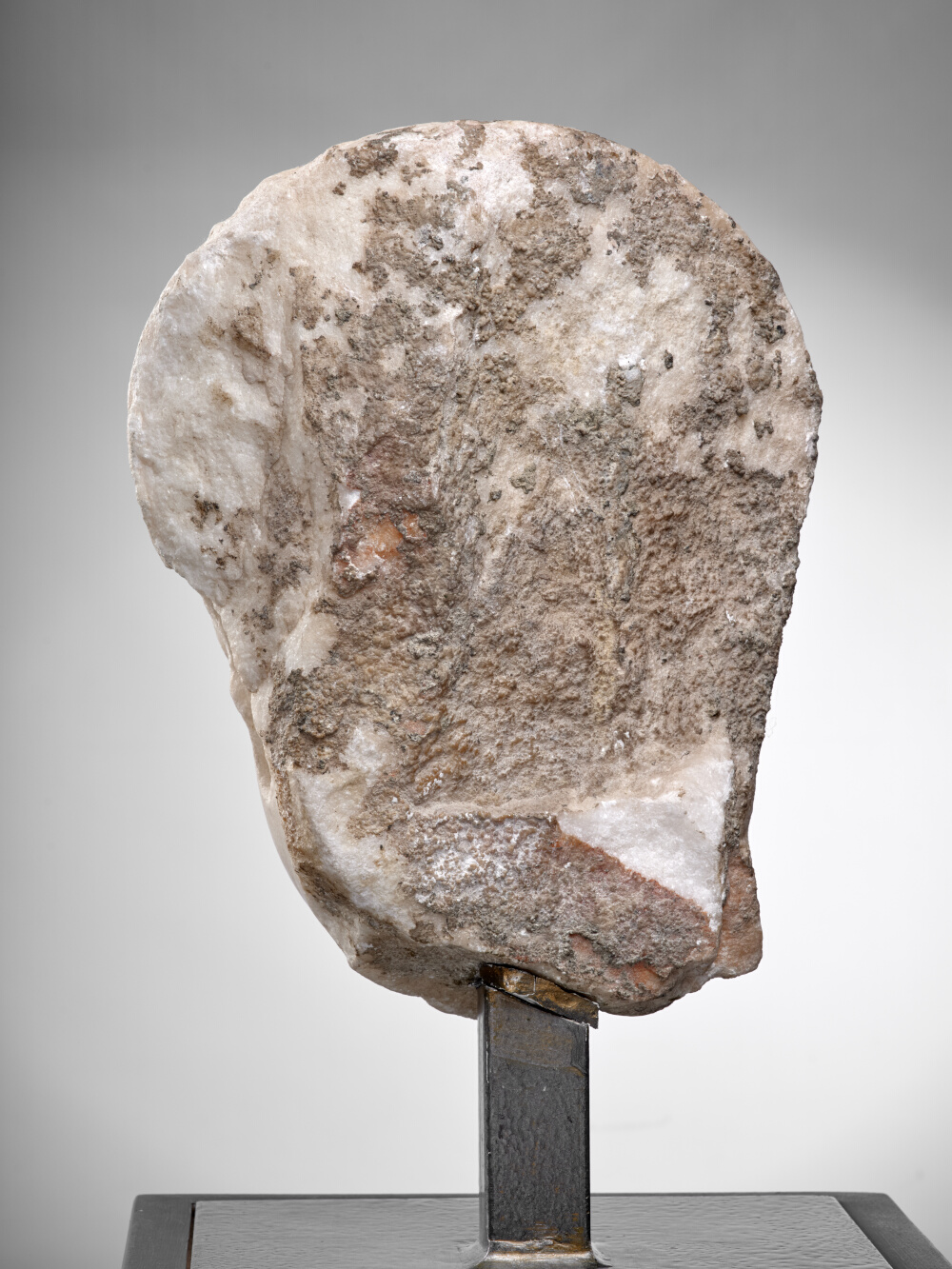
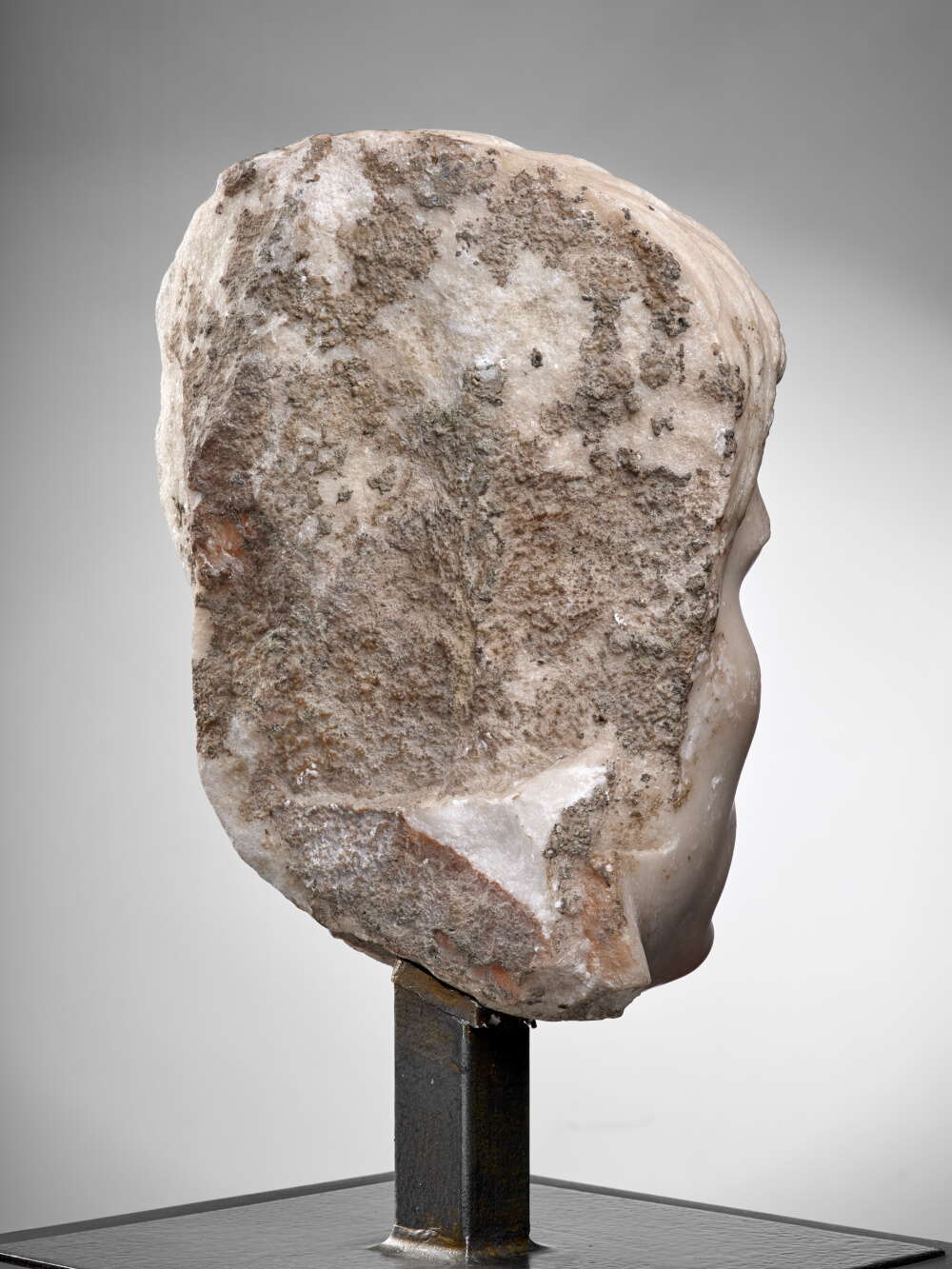
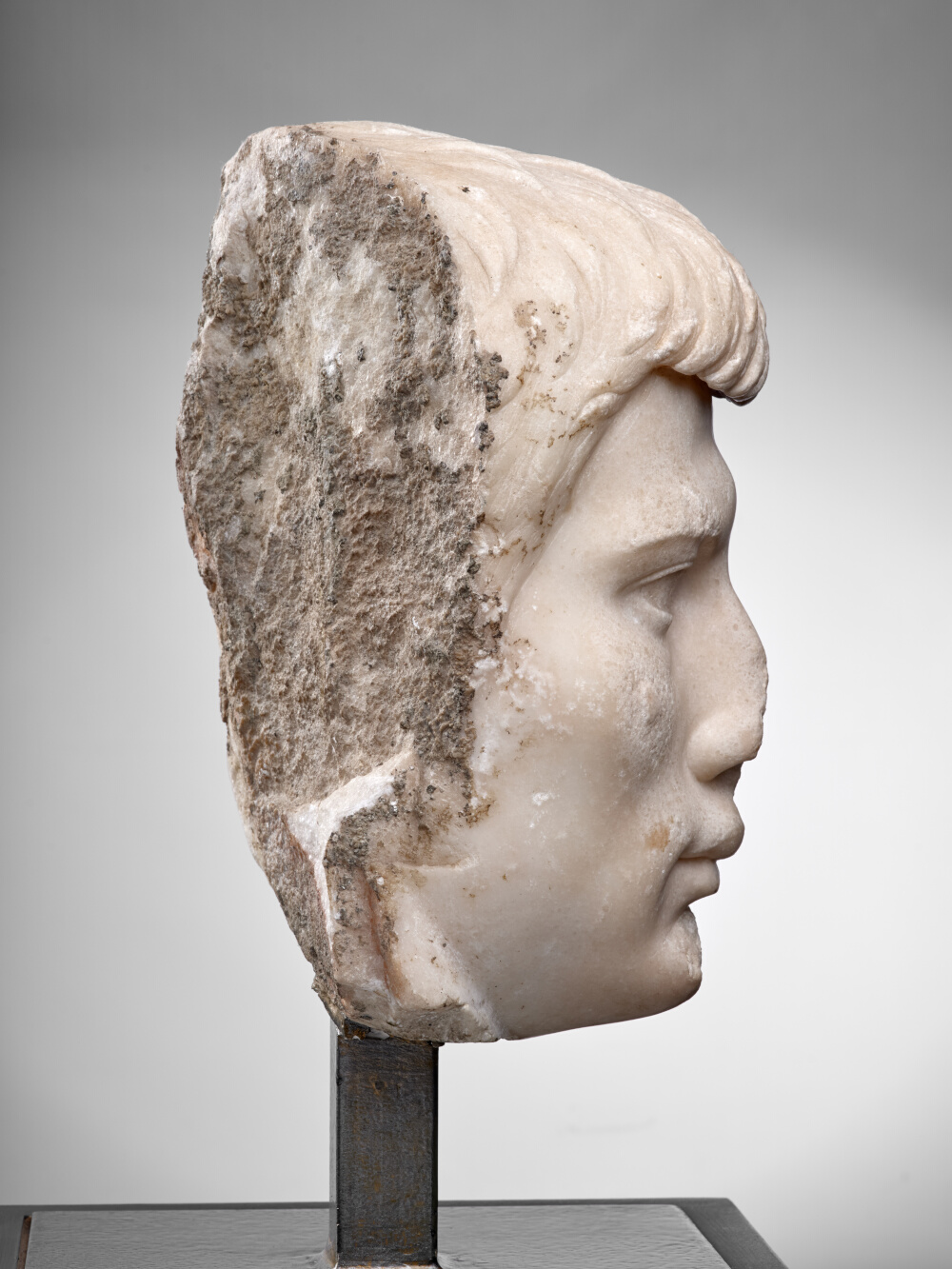
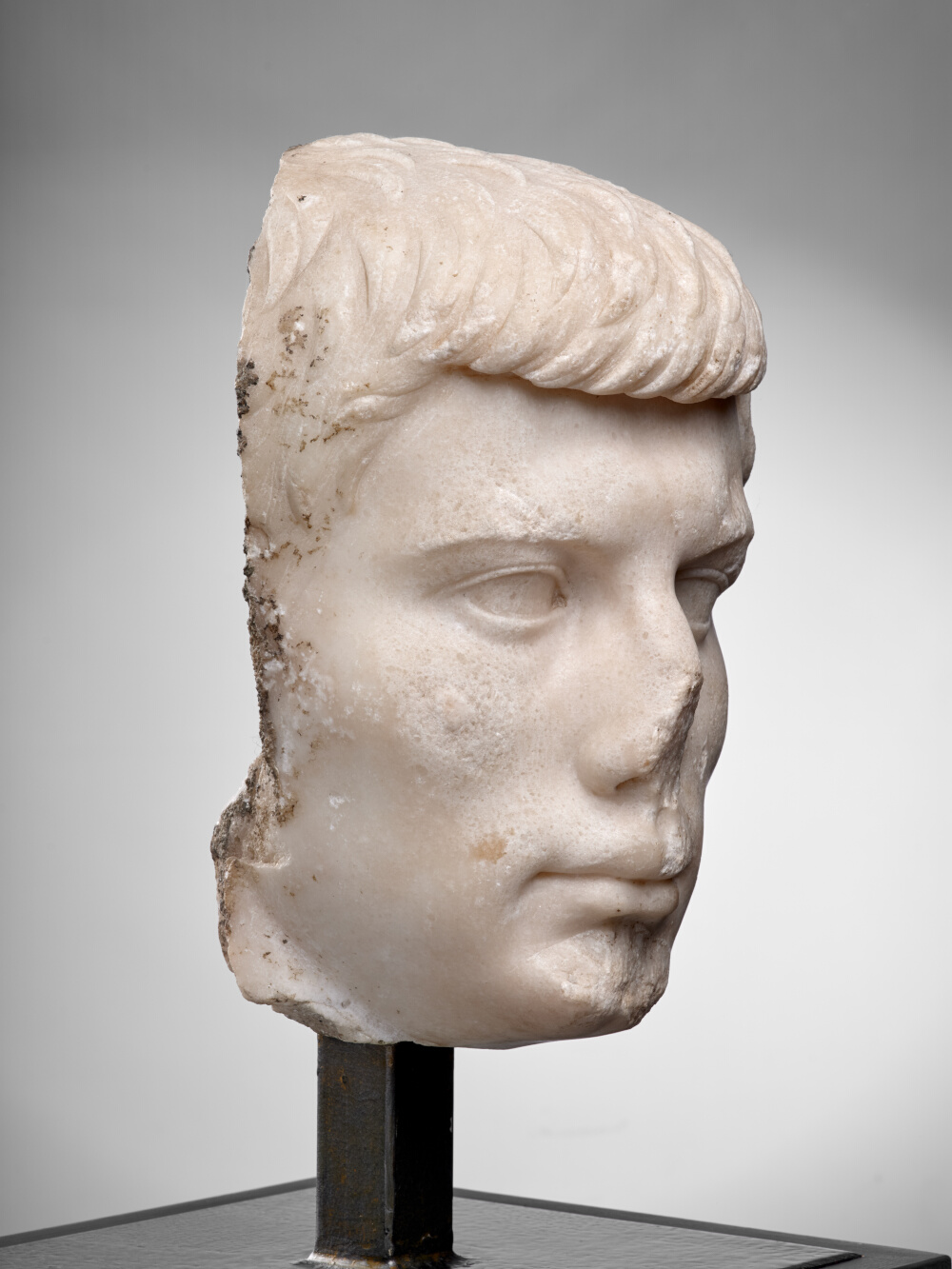
- Biographic data
- 19 - 37/38
Grandson of Tiberius - Date de création
- Year 30 of the 1st century
- Type
- Of the "Capitole-Toulouse" type
- Material
- Lychnites marble (island of Paros)
- Dimensions
- H. 26 x l. 19,5 x P. 17 (cm)
- Inventory number
- Ra 122
- Photo credits
- Daniel Martin
This young boy’s face, still marked by childhood, can only be that of a prince of the imperial Julio-Claudian family, and may therefore date back to the end of the reign of Tiberius or the beginning of that of Caligula (around AD 40). The work is very similar to a head kept in  Rome (at the Capitoline Museums), which has been famous since the 18th century, and is the first issue (« Leitstück »), in other words, the replica of an official iconographic type which, because to its quality, must be considered the work that is closest to the initial creation, or prototype. A total of three portraits belong to the same iconographic type, the first in Rome, as related above, the second in Naples (from Pompeii) R. Bonifacio, Ritratti romani da Pompei, Rome, 1997, no 37, p. 94-96, pl. XXXa-d., which is the eldest, and finally the head in Toulouse. The latter was obviously created by the same workshop as the one at the Capitoline Museums. The teenager’s head was apparently energetically turned to the right, as can be seen from the remaining part of the neck on this side, and the resulting asymmetry. The fringe forms a kind of visor, and refers to a style of hairstyle known since Hellenistic times.
Rome (at the Capitoline Museums), which has been famous since the 18th century, and is the first issue (« Leitstück »), in other words, the replica of an official iconographic type which, because to its quality, must be considered the work that is closest to the initial creation, or prototype. A total of three portraits belong to the same iconographic type, the first in Rome, as related above, the second in Naples (from Pompeii) R. Bonifacio, Ritratti romani da Pompei, Rome, 1997, no 37, p. 94-96, pl. XXXa-d., which is the eldest, and finally the head in Toulouse. The latter was obviously created by the same workshop as the one at the Capitoline Museums. The teenager’s head was apparently energetically turned to the right, as can be seen from the remaining part of the neck on this side, and the resulting asymmetry. The fringe forms a kind of visor, and refers to a style of hairstyle known since Hellenistic times.
This young man has generally always been seen as a member of the domus Augusta; that is the imperial household of Augustus. Marcellus, a nephew of Augustus, is a possible candidate K. Fittschen, P. Zanker, Katalog der römischen Porträts in den Capitolinischen Museen und den anderen kommunalen Sammlungen der Stadt Rom, Mainz, 1985, no 19, p. 19-21., yet Tiberius Gemellus may be a better guess. This young man, born in AD 19, was the grandson of Tiberius and had a twin brother who died in AD 23. He was adopted by his cousin Caligula, thanks to whom he obtained the status of heir presumptive to the throne, and was subsequently assassinated by the same emperor in 37 or 38, allegedly for conspiracy. Tiberius was 17 or 18 at the time. This highly classical work imparts a certain sense of coldness, reinforced by the lifeless fringe, the polished complexion, and the subtle design of the overlapping, sickle-shaped strands of hair. The dominant style of the Tiberian period is obvious, as can be seen in the portraits of the Emperor and his son, Drusus the Younger, father of Tiberius Gemellus.
According to J.-C. Balty 2005, Les portraits romains, 1 : Époque julio-claudienne, 1.1 (Sculptures antiques de Chiragan (Martres-Tolosane), Toulouse, p. 99-118.
Bibliography
- Balty, Cazes 2005 J.-C. Balty, D. Cazes, Les portraits romains, 1 : Époque julio-claudienne, 1.1 (Sculptures antiques de Chiragan (Martres-Tolosane), Toulouse. p. 101-118, fig. p. 100, p. 102 (no 30), 104 (no 34), 105 (no 32), 108, 109, 115 (no 42), 117 (no 43)
- Bergmann 1999 M. Bergmann, Chiragan, Aphrodisias, Konstantinopel : zur mythologischen Skulptur der Spätantike (Palilia), Wiesbaden. p. 28, no 143
- Bonifacio 1997 R. Bonifacio, Ritratti romani da Pompei, Rome. p. 95-96
- Boschung 1993 D. Boschung, « Die Bidlnistypen der iulisch-claudischen Familie : ein kritischer Forschungsbericht, » Journal of Roman Archaeology, 6, pp. 39–79. p. 48
- Boschung 2002 D. Boschung, Gens Augusta : Untersuchungen zu Aufstellung, Wirkung und Bedeutung der Statuengruppen des julisch-claudischen Kaiserhauses (Monumenta artis romanae), Mainz. p. 128-129, no 45.2, pl. 95.2 ("Marcellus ?")
- Cazes et al. 1999 D. Cazes, E. Ugaglia, V. Geneviève, L. Mouysset, J.-C. Arramond, Q. Cazes, Le Musée Saint-Raymond : musée des Antiques de Toulouse, Toulouse-Paris. p. 118, fig. 120
- Curtius 1932 L. Curtius, Ikonographische Beiträge zum Porträt der römischen Republik und der julisch-claudischen Familie (Römische Mitteilungen). p. 229
- Curtius 1948 L. Curtius, « Ikonographische Beiträge zum Porträt der römischen Republik und der julisch-claudischen Familie, » Mitteilungen des Deutschen Archäologischen Instituts. Römische Abteilung (MDAIR), I.
- De Franciscis 1951 A. De Franciscis, Il ritratto romano a Pompei, Naples. p. 47-48
- Espérandieu 1908 É. Espérandieu, Recueil général des bas-reliefs de la Gaule romaine, 2. Aquitaine, Paris. no 957
- Fittschen, Zanker 1985 K. Fittschen, P. Zanker, Katalog der römischen Porträts in den Capitolinischen Museen und den anderen kommunalen Sammlungen der Stadt Rom, Mainz. p. 19-20 à propos du no 19 (réplique "d" ; "Marcellus")
- Giuliano 1987 A. Giuliano, Museo nazionale romano : I, le sculture. 9,1, Magazzini i ritratti, Rome. p. 144
- Hannestad 1994 N. Hannestad, Tradition in Late Antique Sculpture : Conservation, Modernization, Production (Acta Jutlandica. Humanities Series), Aarhus. p. 133, fig. 86-88
- Heilmeyer, La Rocca, Hofter 1988 W.-D. Heilmeyer, E. La Rocca, M. Hofter, Kaiser Augustus und die verlorene Republik. Ausstellung, Martin-Gropius-Bau, Berlin, 7. Juni-14. August 1988, Berlin. p. 329
- Joulin 1901 L. Joulin, Les établissements gallo-romains de la plaine de Martres-Tolosane, Paris. no 268
- Kiss 1975 Z. Kiss, L’iconographie des princes julio-claudiens au temps d’Auguste et de Tibère, Warsaw. p. 66
- Lebègue 1891 A. Lebègue, « Notice sur les fouilles de Martres, » Revue des Pyrénées et de la France méridionale, pp. 573–611. p. 415, pl. XXVIII.1
- Lebègue 1892 A. Lebègue, « Notice sur les fouilles de Martres-Tolosane, » Bulletin archéologique du Comité des travaux historiques, 1, 1, p. 29.
- Massendari 2006 J. Massendari, La Haute-Garonne : hormis le Comminges et Toulouse 31/1 (Carte archéologique de la Gaule), Paris. p. 242, fig. 102
- Pietrangeli 1958 C. Pietrangeli, « Agrippa Postumus, » Enciclopedia dell’arte antica, Rome. p. 159
- Pietrangeli 1938 C. Pietrangeli, La famiglia di Augusto, Rome. p. 44-45
- Queyrel 1992 F. Queyrel, « Antonia Minor à Chiragan (Martres-Tolosane, Haute-Garonne), » Revue Archéologique de Narbonnaise, t.25. p. 78-81
- Rachou 1912 H. Rachou, Catalogue des collections de sculpture et d’épigraphie du musée de Toulouse, Toulouse. p. 60, no 122
- Rosso 2006 E. Rosso, L’image de l’empereur en Gaule romaine : portraits et inscriptions (Archéologie et histoire de l’art), Paris. p. 440-442, no 210
- Rosso 1998 E. Rosso, « Un portrait de Drusus Minor à Nîmes, » Bulletin archéologique du CTHS, 26, pp. 21–31.
- Salviat, Terrer 1980 F. Salviat, D. Terrer, « À la découverte des empereurs romains et de leur famille, à travers les historiens et les portraits de Gaule Narbonnaise, » Les dossiers de l’archéologie, 41, pp. 6–87. p. 69, fig. 4
- Studnicska 1917 F. Studnicska, « Agrippa Postumus, » P. Arndt, W. Amelung (eds.), Photographische Einzelaufnahmen antiker Sculpturen nach Auswahl und mit Text…, Munich, p. 10. à propos du no 1001 p. 10 (Agrippa Postumus)
- Trunk 2002 M. Trunk, Die "Casa de Pilatos" in Sevilla : Studien zu Sammlung, Aufstellung und Rezeption antiker Skulpturen im Spanien des 16. Jhs, Mainz. p. 166 à propos du no 7 (Marcellus)
- West 1933 R. West, Römische Porträt-plastik, Munich. p. 166-167 (Agrippa Postumus)
- Musée Saint-Raymond 1995 Musée Saint-Raymond, Le regard de Rome : portraits romains des musées de Mérida, Toulouse et Tarragona. Exhibition, Mérida, Museo nacional de arte romano ; Toulouse, Musée Saint-Raymond ; Tarragone, Museu nacional arqueològic de Tarragona, 1995, Toulouse. p. 63, fig. 22, p. 87, fig. 45
To cite this notice
Capus P., "Head of an adolescent boy (Tiberius Gemellus ?)", in The sculptures of the roman villa of Chiragan, Toulouse, 2019, online <https://villachiragan.saintraymond.toulouse.fr/en/ark:/87276/a_ra_122>.